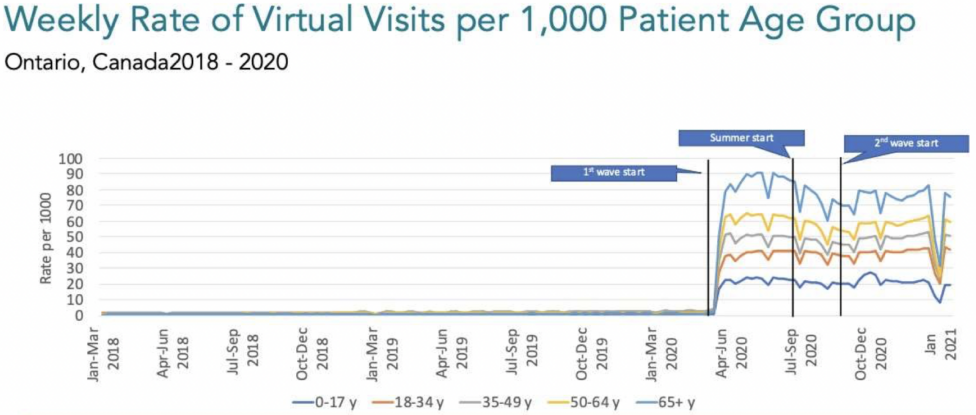The Rocket Doctor will See You

In a crowded virtual healthcare space, how is this start-up is differentiating itself from the rest?
In March 2020 when many Canadians struggled to access healthcare, Rocket Doctor (RD) launched its “digital health marketplace that provides patient care virtually”. Previously, physicians could only bill the government for medical care they rendered in-person, but with the pandemic provincial governments released virtual care billing codes. Overnight, virtual visits skyrocketed (see Figure 1). RD capitalized on the latent demand for virtual care.
Prior to the introduction of virtual visit codes, few companies existed in the Canadian virtual care space. Telus Health and Maple controversially charged patients for virtual visits since they were not billable through the government. Companies paid physicians for each visit along with an hourly rate.

RD’s business model works much like a brick-and-mortar clinic by charging physicians an overhead cost of 15-30% of what they bills in a visit. RD differentiates itself from its competitor in two ways: by focusing on the physician experience and expanding the scope of virtual care.
Focusing on physician experience
Recognizing that the demand for care exceeds the supply of physicians, RD focuses on enhancing the provider experience to attract more providers to the platform, thereby increasing the number of patients seen and revenues. RD mapped and improved virtual care workflows for physicians in:
- booking clinic physicians can book clinic whenever they have free time and decide how many patients they want to see per hour. This is enabled by RD charging a flat overhead fee.
- referral coordination since patients came from all around, referral coordinators help doctors direct referrals to local specialists. This saves doctors times by removing the friction of finding a specific specialist to refer to.
- lab reviews physician assistants are paid by RD to review incoming labs and flag any abnormalities for the doctor who ordered the lab to act on. In traditional care models, doctors have to review hundreds of lab results per day which is not paid time.
- billing submissions RD integrates with billing software so that physicians do not need to spend additional time after visits to submit billings to the government.
- virtual continuing medical education RD regularly invites guest specialists and speakers to discuss new techniques in diagnosing and managing common medical complaints to help improve the quality of care RD physicians provide. These talks otherwise normally cost money to attend.
- incentivizing after hours coverage by decreasing the overhead fees the platform charges and offering bonus money, which increases the number of providers available to see patients after hours again.
Expanding the scope of virtual care
Direct-to-patient diagnostic kits A common criticism physicians had of virtual visits were the lack of tools to diagnose common complaints, such as ear pain – is it just ear wax or is it a bacterial infection? RD developed diagnostic kits with stethoscopes which upload heart and lung sounds, otoscopes which upload images of the ear to the platform, and vital sign monitors so physicians can determine a patient’s heart rate, blood pressure, and oxygen saturation. These kits are couriered to patients ahead of the visit and allow a greater variety of complaints to be seen through RD.
Specialist referral network RD began offering virtual specialist services such as pediatrics, psychiatry, and addictions medicine on the platform. Family doctors are the first point of contact for most Canadians in the healthcare system, treating minor and major complaints. Patients seeing specialists must have a referral from a family doctor. By integrating the primary care service with this specialist service, RD physicians have an even more seamless way of referring patients and can easily access medical records for their patients.
Future directions
At the beginning of 2021, fewer than 5 000 patients were seen per month and by the end of the year, more than 12 000 patients were seen per month. RD is now working on improving its proprietary platform and software to improve existing workflows. The company is also developing relationships with businesses to deliver COVID-19 testing to employees. The market capitalization of virtual care is estimated to be 20 billion CAD in 2021. In May 2021, RD raised 2.7 million USD in seed funding with a valuation of 17.8 million USD.
Like many other companies in the virtual care space, RD quickly scaled and grew to provide virtual care to millions of Canadians without access during the pandemic. RD differentiated itself by leveraging technology to significantly improve workflows which attracted both providers and patients to the platform.



Thank you for your piece. You touched on an essential point for the expansion of digital health services: the provider’s engagement. Nevertheless, many services mainly focus on patient experience in order to capture the high demand generated following the pandemic. I believe that the companies that will succeed in this market will be those that will actively engage clinicians, by providing them a set of integrated services for their practice. An interesting evolution of this concept is “Hospital at home”, a model that enables providers to shift acute care from hospital to patients’ home through a combination of telehealth, remote monitoring technologies, and diagnostics services.